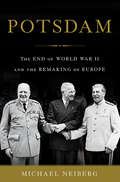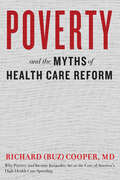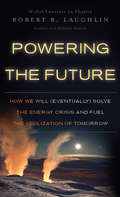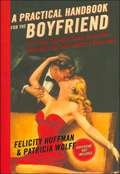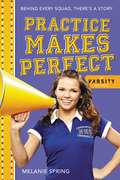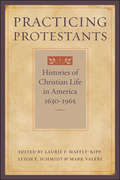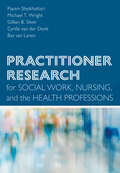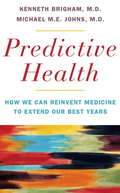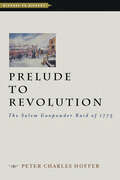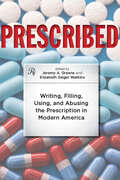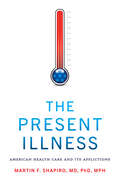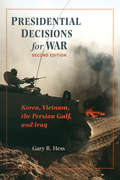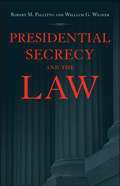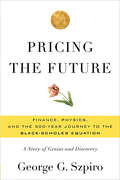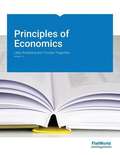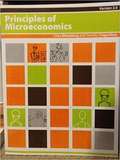- Table View
- List View
Potsdam: The End of World War II and the Remaking of Europe
by Michael NeibergThe definitive account of the 1945 Potsdam Conference: the historic summit where Truman, Stalin, and Churchill met to determine the fate of post-World War II EuropeAfter Germany's defeat in World War II, Europe lay in tatters. Millions of refugees were dispersed across the continent. Food and fuel were scarce. Britain was bankrupt, while Germany had been reduced to rubble. In July of 1945, Harry Truman, Winston Churchill, and Joseph Stalin gathered in a quiet suburb of Berlin to negotiate a lasting peace: a peace that would finally put an end to the conflagration that had started in 1914, a peace under which Europe could be rebuilt.The award-winning historian Michael Neiberg brings the turbulent Potsdam conference to life, vividly capturing the delegates' personalities: Truman, trying to escape from the shadow of Franklin Roosevelt, who had died only months before; Churchill, bombastic and seemingly out of touch; Stalin, cunning and meticulous. For the first week, negotiations progressed relatively smoothly. But when the delegates took a recess for the British elections, Churchill was replaced-both as prime minster and as Britain's representative at the conference-in an unforeseen upset by Clement Attlee, a man Churchill disparagingly described as "a sheep in sheep's clothing." When the conference reconvened, the power dynamic had shifted dramatically, and the delegates struggled to find a new balance. Stalin took advantage of his strong position to demand control of Eastern Europe as recompense for the suffering experienced by the Soviet people and armies. The final resolutions of the Potsdam Conference, notably the division of Germany and the Soviet annexation of Poland, reflected the uneasy geopolitical equilibrium between East and West that would come to dominate the twentieth century.As Neiberg expertly shows, the delegates arrived at Potsdam determined to learn from the mistakes their predecessors made in the Treaty of Versailles. But, riven by tensions and dramatic debates over how to end the most recent war, they only dimly understood that their discussions of peace were giving birth to a new global conflict.
Potsdam: The End of World War II and the Remaking of Europe
by Michael NeibergThe definitive account of the 1945 Potsdam Conference: the historic summit where Truman, Stalin, and Churchill met to determine the fate of post-World War II Europe After Germany's defeat in World War II, Europe lay in tatters. Millions of refugees were dispersed across the continent. Food and fuel were scarce. Britain was bankrupt, while Germany had been reduced to rubble. In July of 1945, Harry Truman, Winston Churchill, and Joseph Stalin gathered in a quiet suburb of Berlin to negotiate a lasting peace: a peace that would finally put an end to the conflagration that had started in 1914, a peace under which Europe could be rebuilt. The award-winning historian Michael Neiberg brings the turbulent Potsdam conference to life, vividly capturing the delegates' personalities: Truman, trying to escape from the shadow of Franklin Roosevelt, who had died only months before; Churchill, bombastic and seemingly out of touch; Stalin, cunning and meticulous. For the first week, negotiations progressed relatively smoothly. But when the delegates took a recess for the British elections, Churchill was replaced-both as prime minster and as Britain's representative at the conference-in an unforeseen upset by Clement Attlee, a man Churchill disparagingly described as "a sheep in sheep's clothing." When the conference reconvened, the power dynamic had shifted dramatically, and the delegates struggled to find a new balance. Stalin took advantage of his strong position to demand control of Eastern Europe as recompense for the suffering experienced by the Soviet people and armies. The final resolutions of the Potsdam Conference, notably the division of Germany and the Soviet annexation of Poland, reflected the uneasy geopolitical equilibrium between East and West that would come to dominate the twentieth century. As Neiberg expertly shows, the delegates arrived at Potsdam determined to learn from the mistakes their predecessors made in the Treaty of Versailles. But, riven by tensions and dramatic debates over how to end the most recent war, they only dimly understood that their discussions of peace were giving birth to a new global conflict.
Poverty and the Myths of Health Care Reform
by Richard Buz CooperIn Poverty and the Myths of Health Care Reform, Dr. Richard (Buz) Cooper argues that US poverty and high health care spending are inextricably entwined. Our nation's health care system bears a financial burden that is greater than in any other developed country in large part because impoverished patients use more health care, driving up costs across the board.Drawing on decades of research, Dr. Cooper illuminates the geographic patterns of poverty, wealth, and health care utilization that exist across neighborhoods, regions, and states;¢;‚¬;€?and among countries. He chronicles the historical threads that have led to such differences, examines the approaches that have been taken to combat poverty throughout US history, and analyzes the impact that structural changes now envisioned for clinical practice are likely to have. His research reveals that ignoring the impact of low income on health care utilization while blaming rising costs on waste, inefficiency, and unnecessary care has led policy makers to reshape clinical practice in ways that impede providers who care for the poor.The first book to address the fundamental nexus that binds poverty and income inequality to soaring health care utilization and spending, Poverty and the Myths of Health Care Reform is a must-read for medical professionals, public health scholars, politicians, and anyone concerned with the heavy burden of inequality on the health of Americans.
Poverty and the Myths of Health Care Reform
by Richard Buz CooperIn Poverty and the Myths of Health Care Reform, Dr. Richard (Buz) Cooper argues that US poverty and high health care spending are inextricably entwined. Our nation's health care system bears a financial burden that is greater than in any other developed country in large part because impoverished patients use more health care, driving up costs across the board.Drawing on decades of research, Dr. Cooper illuminates the geographic patterns of poverty, wealth, and health care utilization that exist across neighborhoods, regions, and states;¢;‚¬;€?and among countries. He chronicles the historical threads that have led to such differences, examines the approaches that have been taken to combat poverty throughout US history, and analyzes the impact that structural changes now envisioned for clinical practice are likely to have. His research reveals that ignoring the impact of low income on health care utilization while blaming rising costs on waste, inefficiency, and unnecessary care has led policy makers to reshape clinical practice in ways that impede providers who care for the poor.The first book to address the fundamental nexus that binds poverty and income inequality to soaring health care utilization and spending, Poverty and the Myths of Health Care Reform is a must-read for medical professionals, public health scholars, politicians, and anyone concerned with the heavy burden of inequality on the health of Americans.
The Power of Selling
by Kim RichmondThe Power of Selling is the perfect textbook to teach students about the proven process of selling. More important, it teaches students how to apply the tenets of selling to how to sell themselves and get the job they want, with the same process professional sales people learn (or brush up) on their own selling skills. What makes someone successful in sales? Are great sales people born or made? Is there one magic selling process, or does the process change based on the business...or the customer? How can the selling process really come alive for students in the classroom? How do students learn how to sell for life, not just for a course? The Power of Selling by Kim Richmond answers these questions and makes the principles of selling come alive. Kim looks at the topic of selling through a different lens, and provides inspiration and ideas. The Power of Selling provides an exciting and interactive experience for both professors and students through the use of 4 unique elements: 1. Content The content is based on the core selling tenets so instructors will find the familiar principles of selling. In addition, the impact of Sales 2.0 is addressed at every stage including how to use interactive tools such as Twitter, LinkedIn, Facebook, blogs, and wikis effectively. 2. Selling U The last section of each chapter is called Selling U. It applies the concepts covered in the chapter to a student's job search. Selling U topics include how to think about yourself as a brand, how to create a powerful cover letter and resume, how to create your personal elevator pitch, how to use networking and informational interviews to get the word out about your brand, how to prepare and dress for an interview, and how to negotiate and accept the right job offer. What makes The Power of Selling different is that Selling U is integrated into every chapter, which makes this text the ultimate guide to selling yourself. 3. Video Resources Videos are used throughout the book. Additional videos that are not included in the text are available for instructor use. Here are videos that are available: * Video Ride-alongs - One of the best ways to learn about sales is by going on ride-alongs. So every chapter starts with an exclusive feature called a Video Ride-along. These short videos feature seven different sales professionals - one that starts each chapter. Each one talks about how he or she applies one of the key concepts covered in the chapter in their job. These videos are designed to be "virtual ride-alongs" so the students can actually feel as though they are getting insights first hand from selling professionals. * The Power of Selling YouTube Channel here (youtube.com/thepowerofselling) - Over 50 videos are included featuring the sales professionals who are highlighted in the Video Ride-alongs. About half of the videos are used in the textbook. The balance are available for instructor use. Several are included in Video Learning Segments (see below). These videos are excellent resources for use in the classroom, exercises, and assignments. * Video Learning Segments In addition to the traditional supplements of Instructor Manual, PowerPoints, and Test Bank, there are also Video Learning Segments. These are PowerPoint slides embedded with videos designed to supplement the course PowerPoints and focus on one concept, like an ethical dilemma, pre-call preparation, or effective presentations, how to use email effectively. Each segment includes slides, videos, discussion questions, or exercises. 4. The Power of Selling LinkedIn Group. here This group was created on LinkedIn.com expressly as a resource for the faculty and students who use this textbook. The group includes sales professionals from across the country and from different industries. This is a great tool for faculty and students alike to network, participate in discussions, ask questions, and connect with "real world" selling professionals.
Powering the Future: How We Will (Eventually) Solve the Energy Crisis and Fuel the Civilization of Tomorrow (Playaway Adult Nonfiction Ser.)
by Robert B. LaughlinIn Powering the Future, Nobel laureate Robert B. Laughlin transports us two centuries into the future, when we&’ve ceased to use carbon from the ground—either because humans have banned carbon burning or because fuel has simply run out. Boldly, Laughlin predicts no earth-shattering transformations will have taken place. Six generations from now, there will still be soccer moms, shopping malls, and business trips. Firesides will still be snug and warm.How will we do it? Not by discovering a magic bullet to slay our energy problems, but through a slew of fascinating technologies, drawing on wind, water, and fire. Powering the Future is an objective yet optimistic tour through alternative fuel sources, set in a world where we&’ve burned every last drop of petroleum and every last shovelful of coal. The Predictable: Fossil fuels will run out. The present flow of crude oil out of the ground equals in one day the average flow of the Mississippi River past New Orleans in thirteen minutes. If you add the energy equivalents of gas and coal, it&’s thirty-six minutes. At the present rate of consumption, we&’ll be out of fossil fuels in two centuries&’ time. We always choose the cheapest gas. From the nineteenth-century consolidation of the oil business to the California energy crisis of 2000-2001, the energy business has shown, time and again, how low prices dominate market share. Market forces—not green technology—will be the driver of energy innovation in the next 200 years. The laws of physics remain fixed. Energy will still be conserved, degrade entropically with use, and have to be disposed of as waste heat into outer space. How much energy a fuel can pack away in a given space is fixed by quantum mechanics—and if we want to keep flying jet planes, we will need carbon-based fuels. The Potential: Animal waste.If dried and burned, the world&’s agricultural manure would supply about one-third as much energy as all the coal we presently consume. Trash. The United States disposes of 88 million tons of carbon in its trash per year. While the incineration of waste trash is not enough to contribute meaningfully to the global demand for energy, it will constrain fuel prices by providing a cheap supply of carbon. Solar energy.The power used to light all the cities around the world is only one-millionth of the total power of sunlight pouring down on earth&’s daytime side. And the amount of hydropump storage required to store the world&’s daily electrical surge is equal to only eight times the volume of Lake Mead. PRAISE FOR ROBERT B. LAUGHLIN &“Perhaps the most brilliant theoretical physicist since Richard Feynman&”—George Chapline, Lawrence Livermore National Laboratory &“Powerful but controversial.&”— Financial Times &“[Laughlin&’s] company … is inspirational.&” —New Scientist
A Practical Handbook for the Boyfriend: For Every Guy Who Wants to Be One/For Every Girl Who Wants to Build One
by Felicity HuffmanMost dating books are written for women -- what a mistake that is. Women know how to date . . . It's men who need the help! At last: a blithe, bold, and bawdy guide to building a better boyfriend At some point, every guy -- player, geek, mama's boy, "regular Joe" -- meets a woman who makes him want to be a boyfriend. A good boyfriend. Problem is, unless he's had some first-rate training (by a previous girlfriend, a sister, a mom), he probably doesn't even know what that means. Felicity Huffman and Patricia Wolff come to the rescue with a rollicking -- and whip-smart -- handbook to navigating the minefield of male-female relationships. Directed at men (though of course it's women who'll buy it, then leave it at their boyfriend's place -- accidentally on purpose), A Practical Handbook for the Boyfriend lays out the many steps involved in becoming a good boyfriend, while still maintaining guy-dignity. It covers issues like: -Who decides when you become a boyfriend (answer: She does.) -How to look like you're listening, even when you're not (If you're busted, just say "You're so pretty, I'm distracted.") -Ten things never to say on the first date (#4: "I just did that to freak you out.") -Finding the middle ground between too cool (think third grade) and too eager (think surprise visits) -Why becoming a good boyfriend is a lot like training for the A team Filled with humor, ribaldry, common sense, and assorted outdoor skills, A Practical Handbook for the Boyfriend is the next dating guide to dominate the bestseller lists.
Practice Makes Perfect (A Varsity Novel #3)
by Melanie SpringBehind every squad, there's a story.It's spring semester at Northside High and the girls of the JV cheer squad are trying out for next fall. The pressure is on as Chloe, Devin, Kate, and Emily practice Varsity-level stunts amidst the drama of best friends, boyfriends, and frenemies. When jealousy and competition threaten to tear these besties apart, can the girls band together to dominate at tryouts?Book 3 in the Varsity series has more best-friend drama, boy trouble, and, of course, sideline spirit!
Practicing Protestants: Histories of Christian Life in America, 1630–1965 (Lived Religions)
by Laurie F. Maffly - Kipp Leigh E. Schmidt Mark ValeriThis collection of essays explores the significance of practice in understanding American Protestant life. The authors are historians of American religion, practical theologians, and pastors and were the twelve principal researchers in a three-year collaborative project sponsored by the Lilly Endowment. Profiling practices that range from Puritan devotional writing to twentieth-century prayer, from missionary tactics to African American ritual performance, these essays provide a unique historical perspective on how Protestants have lived their faith within and outside of the church and how practice has formed their identities and beliefs. Each chapter focuses on a different practice within a particular social and cultural context. The essays explore transformations in American religious culture from Puritan to Evangelical and Enlightenment sensibilities in New England, issues of mission, nationalism, and American empire in the nineteenth and twentieth centuries, devotional practices in the flux of modern intellectual predicaments, and the claims of late-twentieth-century liberal Protestant pluralism. Breaking new ground in ritual studies and cultural history, Practicing Protestants offers a distinctive history of American Protestant practice.
Practitioner Research for Social Work, Nursing, and the Health Professions
by Michael T. Wright Payam Sheikhattari Gillian B. Silver Cyrilla van der Donk Bas van LanenAn invaluable tool for health and social work students and professionals who want to improve their practice through collaborative research with patients, clients, and colleagues.Throughout history, some of the most prominent contributors to health and social sciences have been men and women comfortable with both practice and academia. But today, research in health-related fields is increasingly conducted in specialized settings by people who are first and foremost researchers. Critics bemoan this loss of practice-based research, long considered a vital part of the contribution that doctors, nurses, public health workers, and social workers can make both to their field and the communities in which they work. Unfortunately, the explosion of new discoveries in health-related fields, along with the exponential increase in the amount of knowledge being produced and the growing demands of practice, have caused both the production and application of knowledge to become highly specialized and increasingly complex. This has resulted in a widening gap between research and practice.Recognizing the need for a guide to this type of research, Practitioner Research for Social Work, Nursing, and the Health Professions is a thoroughly reimagined version of a book originally published in 2011 in the Netherlands. Aimed at American practitioners, it is a highly practical guide for anyone in social work, nursing, and other health care and social welfare settings. Its seven-step Practitioner Research Method offers readers a tried-and-true approach to conducting research in their own work environments, and the authors use real-world examples to highlight strategies for overcoming barriers and incorporating research.While leading practitioners through each stage of the research process, the authors explain in detail how to apply a variety of field-tested tools and techniques. A unique and indispensable resource for students in undergraduate and graduate research courses, as well as for seasoned professionals who seek a practical guide for developing and implementing their own research projects in social work, nursing, and the health professions, this book is also the first textbook to introduce the concept and practice of practitioner research to an American audience.
Predictive Health: How We Can Reinvent Medicine to Extend Our Best Years
by Kenneth L. Brigham Michael M. JohnsOur health care system is crippled by desperate efforts to prevent the inevitable. A third of the national Medicare budget—nearly 175 billion—is spent on the final year of life, and a third of that amount on the final month, often on expensive (and futile) treatments. Such efforts betray a fundamental flaw in how we think about healthcare: we squander resources on hopeless situations, instead of using them to actually improve health.In Predictive Health, distinguished doctors Kenneth Brigham and Michael M.E. Johns propose a solution: invest earlier—and use science and technology to make healthcare more available and affordable. Every child would begin life with a post-natal genetic screen, when potential risk—say for type II diabetes or heart disease—would be found. More data on biology, behavior, and environment would be captured throughout her life. Using this information, health-care workers and the people they care for could forge personal strategies for healthier living long before a small glitch blows up into major disease. This real health care wouldn&’t just replace much of modern disease care—it would make it obsolete. The result, according to Brigham and Johns, will be a life defined by a long stay at top physical and mental form, rather than an early peak and long decline. Accomplishing this goal will require new tools, new clinics, fewer doctors and more mentors, smarter companies, and engaged patients. In short, it will require a revolution. Thanks to a decade-long collaboration between Brigham, Johns and others, it is already underway.An optimistic plan for reducing or eliminating many chronic diseases as well as reforming our faltering medical system, Predictive Health is a deeply knowledgeable, deeply humane proposal for how we can reallocate expenses and resources to prolong the best years of life, rather than extending the worst.
Prelude to Revolution: The Salem Gunpowder Raid of 1775 (Witness to History)
by Peter Charles HofferBefore colonial Americans could declare independence, they had to undergo a change of heart. Beyond a desire to rebel against British mercantile and fiscal policies, they had to believe that they could stand up to the fully armed British soldier. Prelude to Revolution uncovers one story of how the Americans found that confidence.On April 19, 1775, British raids on Lexington Green and Concord Bridge made history, but it was an episode nearly two months earlier in Salem, Massachusetts, that set the stage for the hostilities. Peter Charles Hoffer has discovered records and newspaper accounts of a British gunpowder raid on Salem. Seeking powder and cannon hidden in the town, a regiment of British Regulars were foiled by quick-witted patriots who carried off the ordnance and then openly taunted the Regulars. The prudence of British commanding officer Alexander Leslie and the persistence of the patriot leaders turned a standoff into a bloodless triumph for the colonists. What might have been a violent confrontation turned into a local victory, and the patriots gloated as news spread of "Leslie’s Retreat."When British troops marched on Lexington and Concord on that pivotal day in April, Hoffer explains, each side had drawn diametrically opposed lessons from the Salem raid. It emboldened the rebels to stand fast and infuriated the British, who vowed never again to back down. After relating these battles in vivid detail, Hoffer provides a teachable problem in historic memory by asking why we celebrate Lexington and Concord but not Salem and why New Englanders recalled the events at Salem but then forgot their significance.Praise for the work of Peter Charles Hoffer"This book more than succeeds in achieving its goal of helping students understand and appreciate the cultural and intellectual environment of the Anglophone world."—New England Quarterly, reviewing When Benjamin Franklin Met the Reverend Whitefield"A synthetic essay of considerable grace and scope... An excellent overview of the field."—Journal of Legal History, reviewing Law and People in Colonial America
Prescribed: Writing, Filling, Using, and Abusing the Prescription in Modern America
by Elizabeth Siegel Watkins Jeremy A. GreeneAmerica has had a long love affair with the prescription. It is much more than the written "script" or a manufactured medicine, professionally dispensed and taken, and worth hundreds of millions of dollars a year. As an object, it is uniquely illustrative of the complex relations among the producers, providers, and consumers of medicine in modern America. The tale of the prescription is one of constant struggles over and changes in medical and therapeutic authority. Stakeholders across the biomedical enterprise have alternately upheld and resisted, supported and critiqued, and subverted and transformed the power of the prescription. Who prescribes? What do they prescribe? How do they decide what to prescribe? These questions set a society-wide agenda that changes with the times and profoundly shifts the medical landscape. Examining drugs individually, as classes, and as part of the social geography of health care, contributors to this volume explore the history of prescribing, including over-the-counter contraceptives, the patient’s experience of filling opioid prescriptions, restraints on physician autonomy in prescribing antibiotics, the patient package insert, and other regulatory issues in medicine during postwar America.The first authoritative look at the history of the prescription itself, Prescribed is a groundbreaking book that subtly explores the politics of therapeutic authority and the relations between knowledge and practice in modern medicine.
The Present Illness: American Health Care and Its Afflictions
by Martin F. ShapiroBeyond political posturing and industry quick-fixes, why is the American health care system so difficult to reform?Health care reform efforts are difficult to achieve and have been historically undermined by their narrow scope. In The Present Illness, Martin F. Shapiro, MD, PhD, MPH, weaves together history, sociology, extensive research, and his own experiences as a physician to explore the broad range of afflictions impairing US health care and explains why we won't be able to fix the system without making significant changes across society. With a sharp eye and ready humor, Shapiro dissects the ways all groups participating—clinicians and their organizations, medical schools and their faculty, hospitals and clinical corporations, scientists and the National Institutes of Health, insurers and manufacturers, governments and their policies, and also patients and the public—shape and reinforce a dysfunctional system. Shapiro identifies three major problems stymieing reform: commodification of care; values, expectations, unmet needs, attitudes, and personal limitations of participants; and toxic relationships and communication among these groups.Shapiro lays out a sweeping agenda of concrete actions to address the many factors contributing to the system's failings. Highlighting the interconnectedness of both the problems and potential solutions, he warns that piecemeal reform efforts will continue to be undermined by those who believe they have something to gain from the status quo. Although overhauling our health care system is daunting, Shapiro nonetheless concludes that we must push forward with a far more comprehensive effort in all sectors of health care and throughout society to create a system that is humane, effective, and just.
The Present Illness: American Health Care and Its Afflictions
by Martin F. ShapiroBeyond political posturing and industry quick-fixes, why is the American health care system so difficult to reform?Health care reform efforts are difficult to achieve and have been historically undermined by their narrow scope. In The Present Illness, Martin F. Shapiro, MD, PhD, MPH, weaves together history, sociology, extensive research, and his own experiences as a physician to explore the broad range of afflictions impairing US health care and explains why we won't be able to fix the system without making significant changes across society. With a sharp eye and ready humor, Shapiro dissects the ways all groups participating—clinicians and their organizations, medical schools and their faculty, hospitals and clinical corporations, scientists and the National Institutes of Health, insurers and manufacturers, governments and their policies, and also patients and the public—shape and reinforce a dysfunctional system. Shapiro identifies three major problems stymieing reform: commodification of care; values, expectations, unmet needs, attitudes, and personal limitations of participants; and toxic relationships and communication among these groups.Shapiro lays out a sweeping agenda of concrete actions to address the many factors contributing to the system's failings. Highlighting the interconnectedness of both the problems and potential solutions, he warns that piecemeal reform efforts will continue to be undermined by those who believe they have something to gain from the status quo. Although overhauling our health care system is daunting, Shapiro nonetheless concludes that we must push forward with a far more comprehensive effort in all sectors of health care and throughout society to create a system that is humane, effective, and just.
Presidential Decisions for War: Korea, Vietnam, the Persian Gulf, and Iraq (The American Moment)
by Gary R. HessFollowing World War II, Americans expected that the United States would wage another major war against a superpower. Instead, the nation has fought limited wars against much weaker states, such as North Korea, North Vietnam, and Iraq. This revised and updated edition of Presidential Decisions for War analyzes the means by which four presidents have taken the nation to war and assesses the effectiveness of each president's leadership during those conflicts. Gary Hess recreates the unfolding crises in Korea, Vietnam, and Iraq to probe the reasons why Presidents Truman, Johnson, George H. W. Bush, and George W. Bush and their advisors decided in favor of war. He compares the performance of the commanders-in-chief and evaluates how effectively each understood U.S. interests, explored alternatives to war, adhered to constitutional processes, and built congressional, popular, and international support. A new conclusion points out, that unlike the administrations of Truman, Johnson, and the elder Bush, George W. Bush's White House actively sought to change the international order through preemptive war and aggressive democracy building. Fully revised and featuring an examination of how each of the presidents learned from history and juggled the demands on diplomacy, this comparative study of presidential war-making elucidates how effective executive leadership—or its absence—directly affects the outcome of wars.
Presidential Secrecy and the Law
by Robert M. Pallitto William G. WeaverAs seen on The Daily Show, July 24State secrets, warrantless investigations and wiretaps, signing statements, executive privilege—the executive branch wields many tools for secrecy. Since the middle of the twentieth century, presidents have used myriad tactics to expand and maintain a level of executive branch power unprecedented in this nation’s history. Most people believe that some degree of governmental secrecy is necessary. But how much is too much? At what point does withholding information from Congress, the courts, and citizens abuse the public trust? How does the nation reclaim rights that have been controlled by one branch of government?With Presidential Secrecy and the Law, Robert M. Pallitto and William G. Weaver attempt to answer these questions by examining the history of executive branch efforts to consolidate power through information control. They find the nation’s democracy damaged and its Constitution corrupted by staunch information suppression, a process accelerated when "black sites," "enemy combatants," and "ghost detainees" were added to the vernacular following the September 11, 2001, terror strikes.Tracing the current constitutional dilemma from the days of the imperial presidency to the unitary executive embraced by the administration of George W. Bush, Pallitto and Weaver reveal an alarming erosion of the balance of power. Presidential Secrecy and the Law will be the standard in presidential powers studies for years to come.
Pricing the Future: Finance, Physics, and the 300-year Journey to the Black-Scholes Equation
by George G. SzpiroOptions have been traded for hundreds of years, but investment decisions were based on gut feelings until the Nobel Prize-winning discovery of the Black-Scholes options pricing model in 1973 ushered in the era of the "quants.” Wall Street would never be the same. In Pricing the Future, financial economist George G. Szpiro tells the fascinating stories of the pioneers of mathematical finance who conducted the search for the elusive options pricing formula. From the broker's assistant who published the first mathematical explanation of financial markets to Albert Einstein and other scientists who looked for a way to explain the movement of atoms and molecules, Pricing the Future retraces the historical and intellectual developments that ultimately led to the widespread use of mathematical models to drive investment strategies on Wall Street.
Principles of Economics v 1.1
by Libby Rittenberg Timothy TregarthenVersion 1.1 boasts improved coverage throughout the text including significant updates to: Chapters 20 (GDP, Price Level Changes, Business Cycles, and Unemployment) Chapter 21 (Measuring Total Output and Income) Chapter 27 (Government and Fiscal Policy) Chapter 32 (Macroeconomics for the 21st Century).
Principles of Economics Version 2.0
by Libby Rittenberg Timothy TregarthenIn the macro chapters of Version 2.0 of Principles of Economics thoroughly incorporates the recent recession and recovery-- placing it in historical and theoretical context and not shying away from the controversies surrounding how government responded to it. In the micro chapters, all the time-sensitive data has been updated, along with over half of all the "Start Ups" and "Case and Point" applications being brand new or updated. Flat World Knowledge is thrilled to publish a re-launch of Tim Tregarthen's acclaimed Principles of Economics V. 2.0 book, and proud to bring Tim's remarkable talents as a teacher to future generations of students.
Principles of Macroeconomics
by Libby Rittenberg Timothy TregarthenFlat World Knowledge is honored to publish a new, first edition re-launch of Tim Tregarthen's wonderful principles of macroeconomics book, and proud to bring Tim's incredible talents as a teacher back to life so future generations of students can continue to learn from him. In 1996, he published the first edition of his principles of microeconomics textbook to great acclaim, and it became widely used in colleges around the country. That same year, MS made him wheelchair-bound. The disease forced his retirement from teaching at the University of Colorado at Colorado Springs in 1998. He lost the use of his arms in 2001 and has been quadriplegic ever since. Tim never let his disease get him down. In fact, he turned back to his love of writing and teaching for inspiration. He obtained a voice-activated computer, recruited a co-author, Libby Rittenberg of Colorado College, and turned his attention to revising his principles of economics book. Today we are excited to introduce Libby Rittenberg and Timothy Tregarthen's Principles of Macroeconomics. The authors teach economics as the study of "choice " by providing students with an accessible, straightforward overview of economics. This text combines the clarity and writing of Tregarthen's seminal periodical "The Margin" with great teaching insights. Rittenberg and Tregarthen help students to understand how real individuals actually work with economics. In this new book, the authors illustrate the practicality and relevance of economics with a variety of new illustrations and insights. The authors take a three-pronged approach to every concept: (1) the concept is covered with a "Heads Up" to ward off confusion, (2) a "You Try It" section makes sure students are staying on top of the concept and (3) a "Case and Point" section that uses a real-world application to harness the concept in reality. For one example of how this plays out in the text see "Chapter 3, Section 2 on Supply".here This book is intended for a one-semester course in Macroeconomics taught out the social sciences or business school.
Principles of Management
by Mason Carpenter Talya Bauer Berrin ErdoganPrinciples of Management by Carpenter, Bauer and Erdogan teaches management principles to tomorrow's business leaders by weaving three threads through every chapter: strategy, entrepreneurship and active leadership. Strategic: All business school teachings have some orientation toward performance and strategy and are concerned with making choices that lead to high performance. Principles of Management will frame performance using the notion of the triple bottom-line the idea that economic performance allows individuals and organizations to perform positively in social and environmental ways as well. The triple bottom line is financial, social, and environmental performance. It is important for all students to understand the interdependence of these three facets of organizational performance. The Entrepreneurial Manager: While the General Management course at Harvard Business School was historically one of its most popular and impactful courses (pioneered in the 1960s by Joe Bower), recent Harvard MBAs did not see themselves as general managers. This course was relabeled 'The Entrepreneurial Manager' in 2006, and has regained its title as one of the most popular courses. This reflects and underlying and growing trend that students, including the undergraduates this book targets, can see themselves as entrepreneurs and active change agents, but not just as managers. By starting fresh with an entrepreneurial/change management orientation, this text provides an exciting perspective on the art of management that students can relate to. At the same time, this perspective is as relevant to existing for-profit organizations (in the form intrapreneurship) as it is to not-for-profits and new entrepreneurial ventures. Active Leadership: Starting with the opening chapter, Principles of Management show students how leaders and leadership are essential to personal and organizational effectiveness and effective organizational change. Students are increasingly active as leaders at an early age, and are sometimes painfully aware of the leadership failings they see in public and private organizations. It is the leader and leadership that combine the principles of management (the artist's palette, tools, and techniques) to create the art of management. Cases: Mason provides brief cases in his Instructors Manual for those who take a case approach to the course or who wish to incorporate cases. This book's modular format easily maps to a POLC course organization (Planning, Organizing, Leading, and Controlling, attributed to Henri Fayol (1949, General and industrial management. London. Pitman Publishing company), and suits the needs of most undergraduate or graduate course in Principles of Management.
Principles of Marketing 2.0
by Mary Anne Raymond Jeff TannerPrinciples of Marketing Version 2.0 by Tanner, Raymond and Schuster teaches the experience and process of actually doing marketing - not just the vocabulary. It carries five dominant themes throughout in order to expose students to marketing in today's environment: Service dominant logic - This textbook employs the term "offering" instead of the more traditional First "P" -- product. That is because consumers don't sacrifice value when alternating between a product and a service. They are evaluating the entire experience, whether they interact with a product, a service, or a combination. So the fundamental focus is providing value throughout the value chain, whether that value chain encompasses a product, service, or both. Sustainability; Increasingly, companies are interested in the impact they are having on their local community as well as the overall environment. This is often referred to as the triple bottom line of financial, social, and environment performance. Ethics and social responsibility; Following on the sustainability notion is the broader importance of ethics and social responsibility in creating successful organizations. The authors make consistent references to ethical situations throughout chapter coverage, and end of chapter material in most chapters will encompass ethical situations. Global coverage -- Tanner, Raymond and Schuster deliberately entitled Chapter 1; What is Marketing?; Whether it is today's price of gasoline, the current U.S. presidential race, or Midwestern U.S. farming, almost every industry and company needs strong global awareness. And today's marketing professionals must understand the world in which they and their companies operate. Metrics -- Firms today have the potential to gather more information than ever before about their current and potential customers. That information gathering can be costly, but it can also be very revealing. With the potential to capture so much more detail about micro transactions, firms should now be more able to answer ;well, what this marketing strategy really worth it?; And what is the marketing ROI?; And finally, what is this customer or set of customers worth to us over their lifetime? Principles of Marketing Version 2.0 brings new and updated coverage of new developments in the influence of social media to empower consumers, as well as marketing's use of social media, such as sentiment analysis, mobile marketing, and customer service and complaint tracking, as a communications and promotion channel, just a name a few. Version 2.0 also has an overall increased number of examples, as well as, new discussion questions in every chapter (resulting in at least 10 per chapter). In addition, the textbook's key terms, and repeated concepts have been strategically arranged to make customizing this book with Flat World's MIYO platform even easier.
Principles of Microeconomics 2.0
by Libby Rittenberg Timothy TregarthenFlat World Knowledge is honored to publish Version 2.0 (an orginal re-launch) of Tim Tregarthen's wonderful principles of microeconomics book, and proud to bring Tim's incredible talents as a teacher back to life so future generations of students can continue to learn from him.
Professor Stewart's Hoard of Mathematical Treasures: Another Drawer From The Cabinet Of Curiosities
by Ian StewartOpening another drawer in his Cabinet of Curiosities, renowned mathematics professor Ian Stewart presents a new medley of games, paradoxes, and riddles in Professor Stewart's Hoard of Mathematical Treasures. With wit and aplomb, Stewart mingles casual puzzles with grander forays into ancient and modern mathematical thought.Amongst a host of arcane and astonishing facts about every kind of number from irrational and imaginary to complex and cuneiform, we learn: How to organize chaosHow matter balances anti-matterHow to turn a sphere inside out (without creasing it) How to calculate pi by observing the stars...and why you can't comb a hairy ball.Along the way Stewart offers the reader tantalizing glimpses of the mathematics underlying life and the universe. Mind-stretching, enlightening, and endlessly amusing, Professor Stewart's Hoard of Mathematical Treasures will stimulate, delight, and enthrall.
